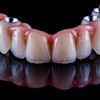
Autonomous dental implant robot systems (ADIRS) demonstrate high accuracy in implant placement, controlling angular deviation and axial errors, according to a study recently published in the Journal of Prosthetic Dentistry.
Additionally, ADIRS can achieve minimally invasive implant procedures, the authors wrote.
"The ADIRS enhances surgical accuracy and promotes minimally invasive dental implant therapies by mitigating issues such as operator fatigue, visual obstructions, and ergonomic challenges,” wrote the authors, led by Dr. Yu Wu of the Peking University Third Hospital in Beijing (J Prosthet Dent, August 13, 2024).
With its six-dimensional robotic arm, ADIRS maneuver better compared to computer-aided dynamic navigation. Furthermore, ADIRS are easier to learn, allowing novices to quickly achieve expert-level accuracy in implant placement under supervised guidance, the authors wrote.
In the study, 74 participants ages 23 to 65 with partial edentulism underwent implant surgery using the ADIRS from May to June 2022. Before surgery, a cone-beam computed tomography (CBCT) scan was performed, and the image data were input into the ADIRS for iterative reconstruction and surgical path planning.
Following preop preparation, the robot, guided by the navigation system, prepared the osteotomy and placed the implant. A postoperative CBCT scan assessed deviations between the planned and actual implant positions, with global coronal, apical, and angular deviations measured and analyzed, they wrote.
 The surgical process of autonomous dental implant robotic system. (A) Positioning marker fixed to contralateral tooth of the same jaw at patient's implant site using interim crown material. (B) Preoperative CBCT examination of participant with positioning maker. (C) Treatment plan designed before surgery. (D-F) Autonomous dental implant robotic system in use. (G) Postoperative evaluation: comparing the accuracy of preoperatively planned implant position (in blue) with the actual postoperative position.
The surgical process of autonomous dental implant robotic system. (A) Positioning marker fixed to contralateral tooth of the same jaw at patient's implant site using interim crown material. (B) Preoperative CBCT examination of participant with positioning maker. (C) Treatment plan designed before surgery. (D-F) Autonomous dental implant robotic system in use. (G) Postoperative evaluation: comparing the accuracy of preoperatively planned implant position (in blue) with the actual postoperative position.
Using a generalized linear mixed model (GLMM), the differences in key outcome variables was evaluated. A total of 86 implant procedures were successfully completed without complications. The mean standard deviation for global coronal deviation was 0.61 ± 0.20 mm (95% confidence interval [CI], 0.23 to 1.0 mm).
The global apical deviation was 0.79 ± 0.32 mm (95% CI, 0.17 to 1.41 mm), and the angular deviation was 2.56 ± 1.10 degrees (95% CI, 0.42° to 4.70°). The GLMM analysis showed that both the implant region (premolar, molar; maxilla, mandible; left, right), implant length, and the surgeon did not significantly impact accuracy (p >.05), according to the results.
The study had limitations. ADIRS require a large operating room, additional personnel, and it is expensive, the authors wrote.
"These findings suggest that the ADIRS can be a reliable and efficient option for dental implant surgery," they concluded.




















